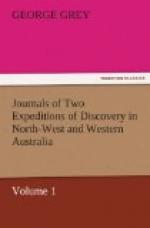CHARACTER OF THE RIVER.
To those who have never seen a river similar to the one we were now upon it is difficult to convey a true idea of its character. It consisted of several channels or beds divided from each other by long strips of land, which, in times of flood, become islands; the main channel had an average breadth of about two hundred and seventy yards; the average height of the bank at the edge of it was about fifteen feet, and the bed of the river was composed of porous red sand apparently incapable of containing water unless when previously saturated with it. After passing the highest point reached by the sea this huge river bed was perfectly dry, and looked the most mournful, deserted spot imaginable. Occasionally we found in this bare sandy channel waterholes of eighteen or twenty feet in depth, surrounded with tea trees and vegetation, and the driftwood, washed high up into these trees, sufficiently attested what rapid currents sometimes swept along the now dry channel. Even the waterholes were nearly all dried up, and in the bottom of these the natives had scooped their little wells.
The river channel ran up in a due north-east direction for about four miles without in the least altering its character. It was in vain that we walked over the intervening slips of land into the side channels; these in all respects except in being narrower exactly resembled the main one; and, after ranging across from bank to bank in this way, the only general conclusion I could arrive at was that the country upon the northern bank of the river appeared scrubby and covered with samphire swamps, whilst that upon its southern bank seemed rich and promising.
EXPLORE THE COUNTRY INLAND TO THE NORTH OF THE RIVER.
The river now made a sudden turn to the east by north, and we followed it in this direction for three miles and a half without finding the slightest change in its character or appearance. No high land whatever was in sight, and from a low rounded hill, which was the highest point we could see, the rise of the country towards the interior was scarcely perceptible; indeed it presented the appearance of being a vast delta; and such I then and subsequently conjectured it to be.
During our walk up the bed of the river we had seen many cockatoos, some wildfowl, and numerous tracks of natives; these all appeared to me to be indications of a well watered and fertile tract of country.




